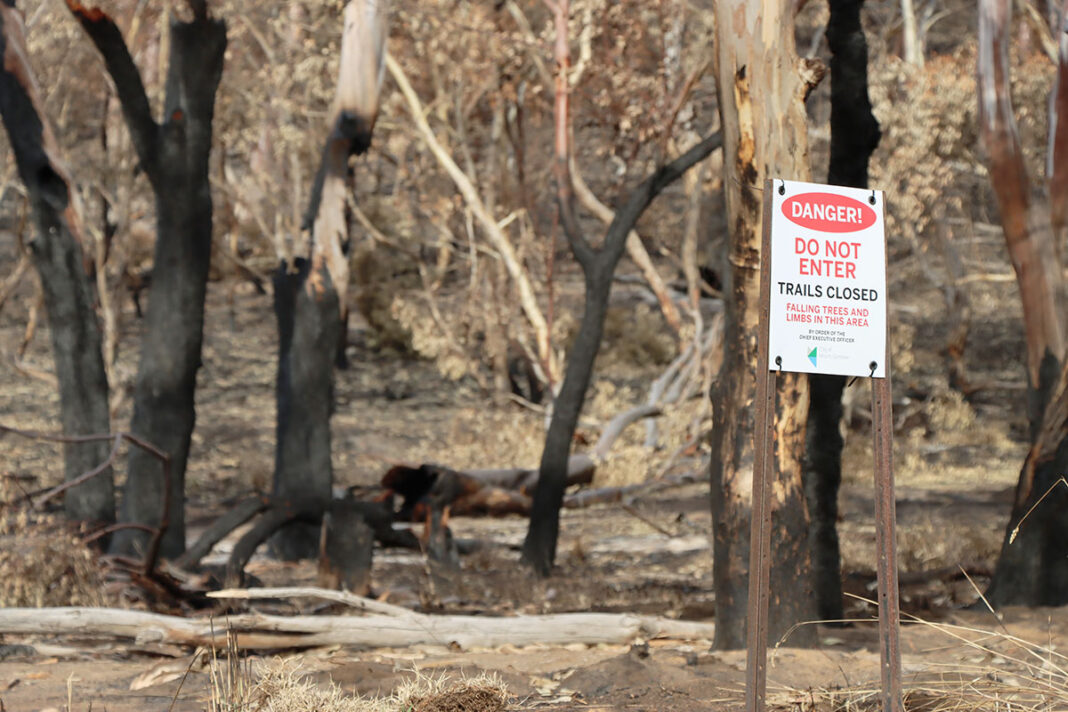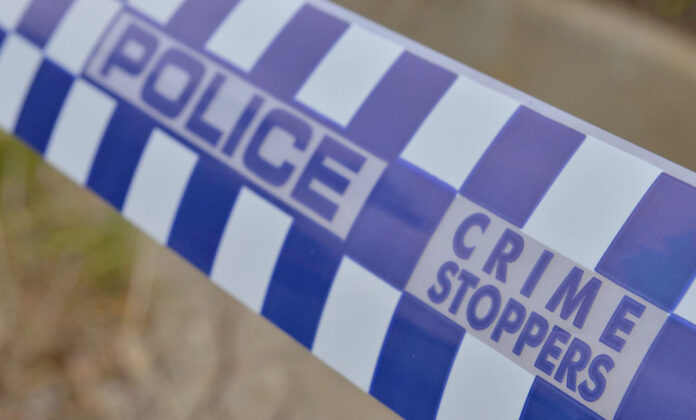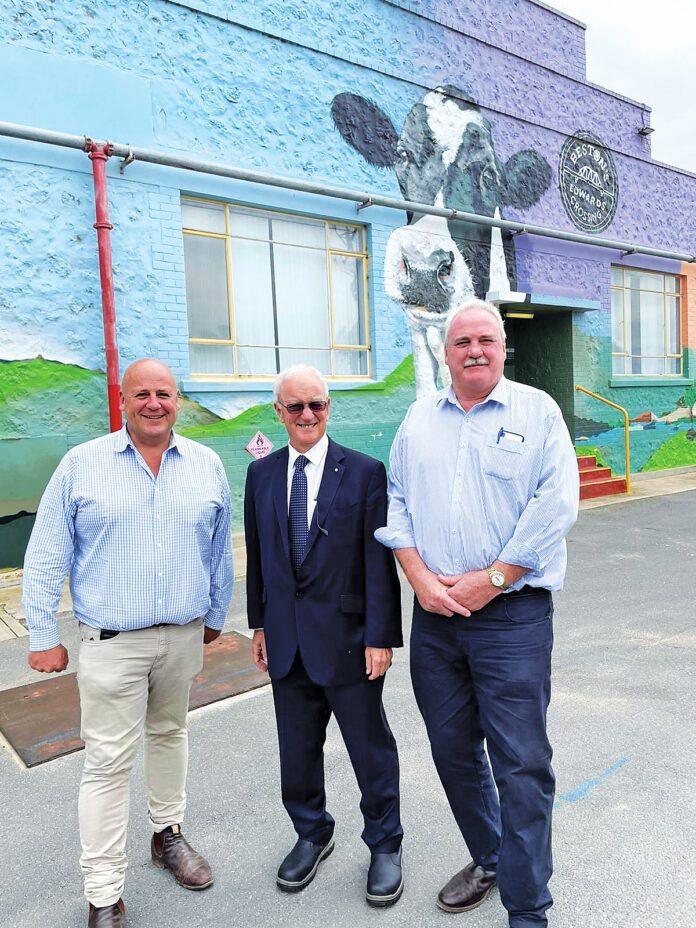Fire affected areas of the Crater Lakes precinct could remain closed for at least another two weeks.
This was highlighted by Mount Gambier City Council chief executive Sarah Philpott during discussion at a special council meeting last week.
It has been three weeks since fire engulfed a significant portion of the city’s tourist attraction.
Council called the public meeting to discuss the immediate response and early recovery of the 50 hectares of burned grass and scrub at the iconic Mount Gambier site.
Sections have been reportedly still smouldering while burned and fallen limbs also pose a risk to public safety with bunting and signage have been installed around the precinct warning the community to keep out of the hazardous area.
With Council’s Governance and Property manager Michael McCarthy, Ms Philpott tabled a seven-page Crater Lakes Bushfire Response and Recovery report outlining a number of recommendations relating to fire and associated procurement, road closures, budget and delegation requirements to form part of an assessment and recovery process.
Ms Philpott said some areas would be off limits for longer periods of time.
“There will remain some areas affected which will require more detailed assessment before reopening,” she said.
The fire was first reported on January 25 and for the two days that followed emergency services had control of the fire site.
The site was returned to the care and control of council on January 27.
Mr McCarthy reported the Metropolitan Fire Service (MFS) provided council with advice regarding the ongoing closure of the area.
“At handover, the MFS provided advice to ensure public safety for a week after the fire was contained,” he said.
“The MFS continued to monitor the area after hand back and have continued to liaise and assist council in starting assessment activities.
“Road and site closures remained in place across the whole of the precinct for several days in line with those safety requirements.”
Authority and decision making regarding the prohibition and eventual permitting of traffic and the public into the area lies with council.
Immediate control has been managed under council’s road traffic and traffic management device powers associated with works being undertaken in the fire affected area.
However, Mr McCarthy said alternate powers provided more appropriate control of the site over the recovery period. These were addressed further in the report and in the recommendations.
The report noted some fire affected areas require more detailed assessment before reopening.
Now the site is past the immediate emergency response, council has proposed a four-stage recovery process.
This includes securing the fire affected site, risk assessment and zoning, assessment of fire damage and recovery measures, with the final stage being reopening of zones deemed high-risk.
“The resolutions contained in the report are for more immediate expenditure and procurement which may be outside of existing budgets,” Mr McCarthy reported.
Due to the unforeseen nature of the event and associated implications, Mr McCarthy said exemption provisions within council’s procurement policy may be required to enable the recovery process.
Community members are reminded significant dangers remain and continually advised about remaining out of the site.
As part of the risk assessment and zoning council officers have been working in collaboration with MFS to assess the risk of the fire affected areas and perform a comprehensive risk assessment for safety measures.
Areas identified as “low risk” to “none” are planned to be opened for public access.
The community has recently been welcomed back to enjoy some of the picturesque areas unaffected by the fire as [part of this process.
Last Friday (February 11) Leg of Mutton, Saddle and Marist Park Oval (only for organised sports) was reopened.
A map highlighting reopened areas has been made available on council’s website, which also identifies the area that currently remains closed.
“Currently the ‘Pines Area’, ‘Centenary Tower’, ‘Blue gum trails’ and the ‘Browns Reserve’ fall into the category of severely fire affected areas,” Mr McCarthy said.
“The current risk of entering these areas is still ‘very high’ and will be continually monitored and is likely to remain high for a protracted period.”
Areas identified as ‘high risk’ will gradually be reopened when considered safe to do so.
The power of closing and reopening of the fire affected land has been delegated to the chief executive.
Mr McCarthy reported this would be the most efficient was of managing the complexity of the matter.
The closure of fire affected land and roads is in line with council’s by-laws and the Local Government Act.
It was reported further closing of land and roads may be necessary.
“Risk implications including public safety are of the highest priority in the recovery period. Full risk implications are yet to be determined,” Mr McCarthy said.
“It is anticipated that a subsequent report will address such issues.”
Meanwhile elected members would be kept up to date both formally and informally as recovery efforts progress.
Nearby residents and businesses have been contacted by council to provide feedback.
Council intends to work with other agencies in the long-term recovery process.
The Landscape Board, Parks and Wildlife, Country Fire Service (CFS) and MFS, animal and wildlife specialists and specialist arborists have been earmarked to help council in determining the extent of the recovery process and subsequent timeframe.
Council is yet to develop an implementation strategy.
“Assessments of the affected area are continuing. It is anticipated that a subsequent report will address such issues,” Mr McCarthy said.
Before closing the meeting Mayor Lynette Martin took the opportunity to acknowledge and thank all emergency services, staff and volunteers involved in fighting the fire, as well as residents for remaining away from the site in the peak of the emergency.
Several recommendations were listed in the report. They can be viewed in full in the meeting minutes available on council’s website.
During the meeting Cr Max Bruin moved an amendment, omitting “with approval” to report recommendation 9. This was seconded by Cr Paul Jenner.
Other report recommendations were moved without alteration.
The recommendations were supported by Crs Sonya Mezinec and Frank Morello.
Crs Christian Greco, Steven Perryman, Kylie Amoroso and Ben Hood were absent from the meeting.




